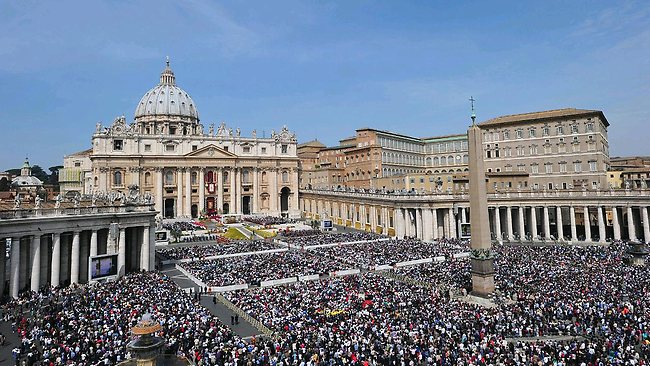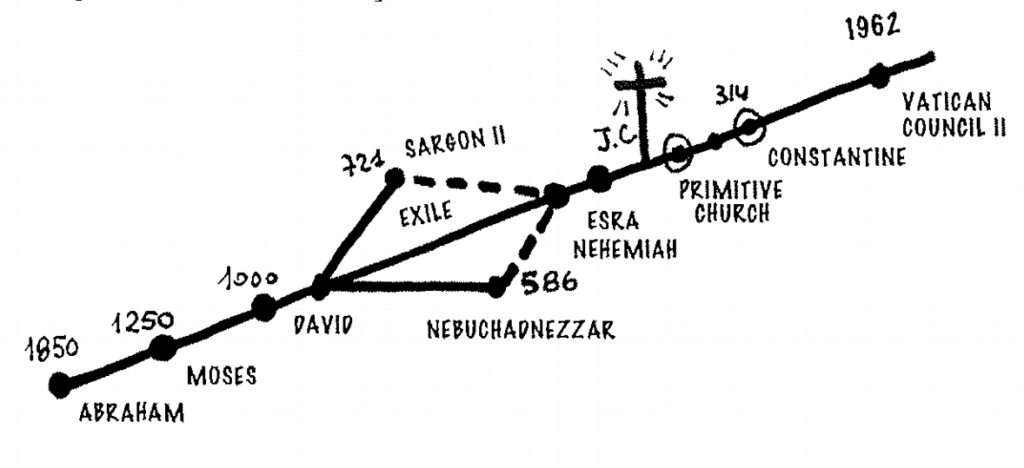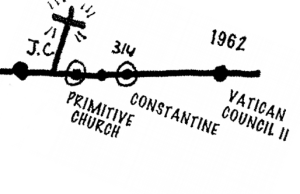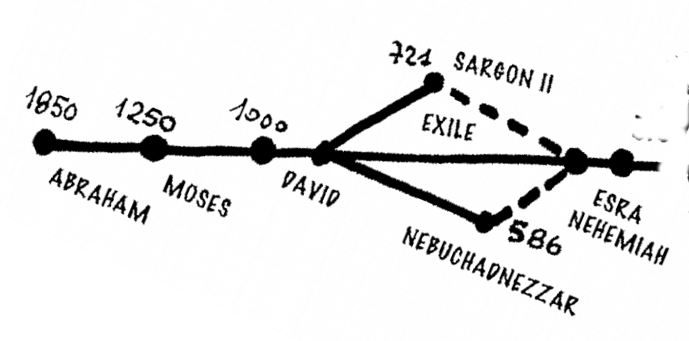They say that a picture is worth a thousand words and Kiko Arguello, an artist and the founder of the Neocatechumenal Way, certainly knows how to use them effectively in his teaching.
Here is Kiko’s diagram of Salvation History taken from page 53 of the first volume of the Neocatechumenal Catechetical Directory, otherwise known as “Guidelines for Teams of Catechists”:
Like any timeline, one should read this from left to right. One can see that Church history starts from the figure of the Cross. Let’s zoom in on that part of the timeline:
What do you think? Did Kiko miss anything?
Well, he’s got the beginning in there, and he’s got Constantine (and his Edict of Milan by implication). And of course I’m glad he thought to include the Second Vatican Council. But what’s in between Constantine and Vatican II? Nothing, absolutely nothing.
Does this strike you as strange? What about the other twenty ecumenical councils? The Councils of Nicaea and Constantinople where the heresy of Arianism was finally turned back after sweeping through two thirds of the Church? Or the Council of Trent which addressed the problems at the root of the Protestant reformation? No, they are all missing.
And if the councils aren’t your cup of tea, what about the cataclysmic split of Churches of the East and West in 1054 AD? Or the rolling Protestant reformation five centuries later?
And people. Why aren’t any of the great Doctors of the Church listed? St. Augustine, for example, or St. Thomas Aquinas? Or how about the two mendicant friars who shook up and brought great renewal to the Church, St. Dominic and St. Francis? Or the great mystics, like St. John of the Cross or St. Teresa of Avila, to name just two?
I could go on and on, but I’ll tell you why I think Kiko’s timeline of Church history is blank: he does not believe that anything worthy of note happened in Church between the Emperor Constantine and the Second Vatican Council. For him, it was a dead time, a time of apostasy, bureaucracy, and malaise. The Holy Spirit must have been sleeping, no? Until, of course, he, Kiko Arguello, showed up on the scene, two years after the start of the Second Vatican Council.
There’s more…
Thus far, I have only concentrated on the history of the Church, and neglected the left side of the timeline. Taken together, Kiko is describing his version of Salvation History and trying to make a point while doing so. Let’s look at this side now:
There are a few interesting things to notice about that side of the picture. For one, he doesn’t start out with the Fall of Man, as you would expect, but rather with Abraham. He does have Moses and David in there, as he should, but he leaves out a lot in favor of the Babylonian Exile. Why is that? The exile certainly is part of Salvation History, but why let it dominate the timeline? Well, notice that Ezra and Nehemiah are listed. Ezra and Nehemiah were a priest and layman who rebuilt Jerusalem after the Exile and reestablished proper Temple worship and the practice of the Mosaic Law in Jerusalem. Of course, this was good, but their presence on the timeline and the emphasis on the Exile is supposed to complement the time that the Holy Spirit was asleep between Constantine and the Second Vatican Council and Kiko’s arrival. Ezra and Nehemiah “rebuilt Judaism” (Kiko’s words) and Kiko will rebuild the Church.
So the question is, has the Church been destroyed, like Jerusalem after the Exile, and are we looking for the Church to be rebuilt by Kiko? Or, despite our sinfulness, has the Holy Spirit indeed been at work in our Church since Constantine, and instead are we seeking its authentic renewal?
Tags: Neocatechumenal Way, Camino Neocatecumenal, problems, problemas




this is consistent with the apparent tendency of neocats to consider themselves–and in particular their form of liturgy–as a revival of the “primitive church,” which was the Church at its purest. the biggest problem with that viewpoint is that it disregards the work of the Holy Spirit. perhaps it hasn’t yet occurred to kiko that a Church sustained by the Holy Spirit is alive, and that the essence of life is dynamism, growth, and development.
There’s a lot more that can be said about Kiko’s timeline. I only concentrated on the history of the Church, and neglected, for the time being, the left side of the timeline. Taken together, Kiko is describing his version of Salvation History.
There are a few interesting things to notice about that side of the picture. For one, he doesn’t start out with the Fall of Man, as you would expect, but rather with Abraham. He does have Moses and David in there, as he should, but he leaves out a lot in favor of the Babylonian Exile. Why is that? The exile certainly is part of Salvation History, but why let it dominate the timeline? Well, notice that Ezra and Nehemiah are listed. Ezra and Nehemiah were a priest and layman who rebuilt Jerusalem after the Exile and reestablished proper Temple worship and the practice of the Mosaic Law in Jerusalem. Of course, this was good, but their presence on the timeline and the emphasis on the Exile is supposed to complement the time that the Holy Spirit was asleep between Constantine and the Second Vatican Council and Kiko’s arrival. Ezra and Nehemiah “rebuilt Judaism” (Kiko’s words) and Kiko will rebuild the Church.
So the question is, is the Church destroyed, like Jerusalem after the Exile, and are we looking for the Church to be rebuilt? Or, despite our sinfulness, has the Holy Spirit indeed been at work in our Church since Constantine, and instead are we seeking its authentic renewal?
What I would like to know, does Kiko provide any references or historical documentation to accompany this timeline? Or is this just his own interpretation?
I am still beside myself that there are many who attend this catechism that I would think know better than to just follow without inquiry – lock, stock and barrel.
Same with the Saturday “service.” There is so much questionable and illicit liturgy contrary to the general instructions of the Roman Rite that I am confounded as to how it has been allowed to continue! Again, is there any reference or guide book that explains their Saturday “service?”
A lot of customization occurs in the NCW, especially where none is needed, nor are any of the allowances adhered to in so much as their approved statutes.
Jose, Kiko’s “Guidelines for Teams of Catechists” aka “Catechetical Directory” is footnoted, but the footnotes often seem to contradict the points that he tries to make. This is especially true when the footnotes reference the Catechism. This is so true that I think the references from the Catechism are a sort of “window dressing” to make the documents more palatable to the reviewers at the Vatican.
Kiko cites the works of at least two theologians in his first volume: Louis Bouyer and Yves Congar, but only quotes from Bouyer. Even though he mentions Bouyer, he spends lots of time contradicting what Bouyer actually taught, especially about the liturgy and the altar, so I suspect Kiko is using those references as a sort of “red herring”.
This is particularly odd if one consider that 2/3 of this timeline are occupied by Israel history and a great fork has been drawn to point up the end of Israel kingdom. Looking this timelilne enlighten what is important for Kiko in history of Salvation: the Old Testament and himself.
Thank you, Sandavi. I would like to clarify something about Kiko and his love for the Old Testament. Specifically, it’s a feigned love. Kiko believes that Judaism and Christianity have been contaminated by archaic religious systems with their ritual sacrifices, so he trashes or ignores all of the Old Testament sacrificial ordinances, which the Church Fathers considered to be types or prefiguring of His sacrifice on Calvary and the Eucharistic sacrifice. I try to address this subject in my two posts Kiko’s Passover Problem, Part I and Kiko’s Passover Problem, Part II.
Kiko is patenty ingnorant of the Church’s great doctors, such as Origen (who is the one who makes the case Old Testament worship being a type of the Cross and the Eucharist), or the Cappadociann Fathers , St. John Chrysostom , not to mention St. Augustine, St. Thomas Aquinas who happen to be the two greatest doctors in the history of the Church. Besides, the whole notion of nothing happening from Constantine to Vatican II is an idea taken from Protestants, in their effort to justify te false reform of Luther and Calvin. Supposedly the true Church of Christ dispapeared and they are not in agreement when that happened.
As regards the Eucharistic sacrifice, all of the Fathers clearly teach it, and for good reason St. John Chrysostom is called the Doctor of the Eucharist, but he is accompanied by all of them.
you know what comes next? neocats defending their catechetical directory by saying it’s been approved by the vatican.
And if that’s their response, I would ask them a few things:
1) Did I misquote the catechetical directory? If so, then show me the correct version.
2)If not, then show me how I have erred in my conclusions.
3) If the directory has been approved, then tell me why it’s being kept secret.
One leader of the Neocatechumenal Way ( English ) have said repeatedly that they are better than the other prayer groups because “they know The Way ” to be holy,and/or go to Heaven. I asked two priests who says their ‘Mass’; one said “its not true, the Holy Spirit works on us differently …” but the Pastor, a high ranking official of their small Congregation told a parishioner,
“… in a way she is right; their Way to holiness is long and hard, and in several steps…”
And, by the way, they don’t believe in praying to Saints for intercession… pray directly to Jesus ONLY.
The parishioner have since left the Parish.
That’s exactly what they keep on saying… and, sadly the Pastor in my former Parish was pressuring me to join the Neo, hoping my co-members of the Padre Pio Prayer Group will follow . How can I join a group who takes pride in saying “they are better than the others ( prayer groups) in the Church”.. And the same Pastor agrees with them.
Be strong, Gloria. And ask for Padre Pio’s intercession.
Thank you, that’s what I did after I left the Parish. Result ? The Pastor and the local Auxiliary Bishop have banned me from forming another Padre Pio PrayerGroup in other parishes. The ‘smear campaign’ is extended to all local pastors and the newly assigned Auxiliary Bishop. One Pastor said prayer groups have no place in New Evangelization, unlike the Neo. I struggled with my Faith for a while, then I just accepted that maybe God has something else for me. I have joined other P.Pio Prayer Groups ever since, even their Papal Audience last Feb. 6, 2016, in Rome.
Wow! Is this in California?? Did they say exactly why “prayer groups have no place in the New Evangelization”? Or is it just Padre Pio groups that they don’t like? What about the Ultreya’s of the Cursillo Movement, or Charismatic Prayer Groups?
Baby G, I’ll contact you by email.
Thank you for highlighting the red herrings, the “sanitized” versions for official “approval”, the contradicting of purported sources. I used to put it down to amateurism (which was widespread in the Church anyway) and only took from the catecheses what suited me. I was a “cafeteria Kiko”!
Why did Kiko choose 314 as the year of Constantine, the edict of Milan was in 313
Kiko omits the history between Constantine snd Vatican II because it is not necessary to include to make the point of this catechesis. Moreover, the Neo Catechumenal Way IS Vatican II truly implemented.
I’ve always suspected that members of the Way are taught that their movement is more than just a fruit of the Second Vatican Council, but rather is THE implementation of it. Your comment bolsters my belief.
There certainly is a need for post-baptismal catechesis in the Church today, that is, a catechesis for adults that promotes conversion and “metanoia”, the ongoing change of heart experienced by a true disciple of Jesus Christ. Indeed, this was called for by the Fathers of the Second Vatican Council . Call this catechesis a “post-baptismal catechumenate” if you wish. [CCC 1231].
But nowhere do the Council Fathers suggest that this post-baptismal catechesis should result in closed, self-absorbed communities that parasitically suck the life out of parishes.
Nowhere do they suggest that this post-baptismal catechesis should be an end in itself.
Nowhere do they suggest that it center on an unhealthy cult of personality around it’s 20th century founder.
Nowhere do the Council Fathers say that this effort should place an exaggerated emphasis upon the reality of “persecution”.
Nowhere do they say that doctrinal teachings should be deformed in this catechesis.
And nowhere do the Council Fathers suggest that this post-baptismal catechesis should be led by an authoritative hierarchy of catechists that are appointed independently and act independently of the bishops and parishes that they are supposed to serve.